2018 MERCEDES-BENZ S-CLASS SEDAN change wheel
[x] Cancel search: change wheelPage 25 of 562
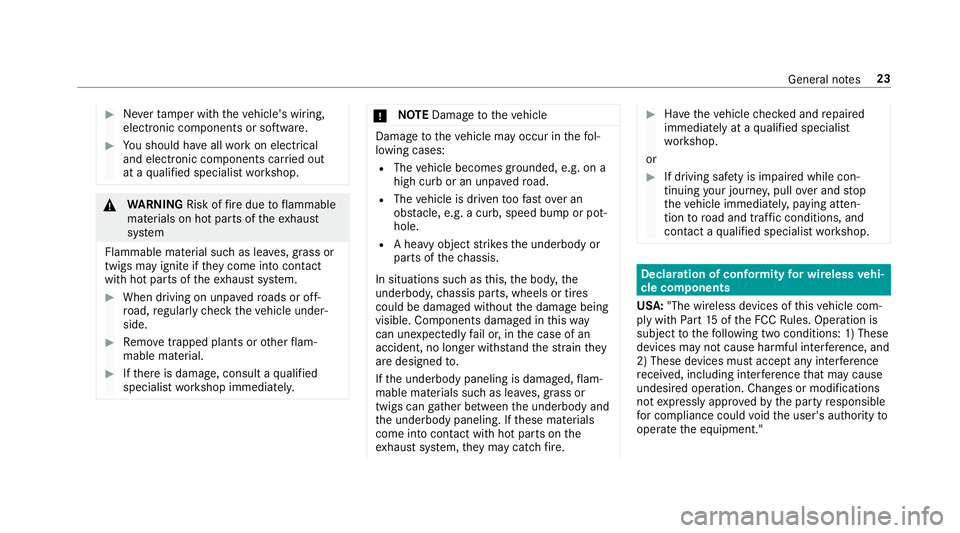
#Neverta mp er with theve hicle's wiring,
electronic components or software.
#Yo u should ha veall workon electrical
and electronic components car ried out
at a qualified specialist workshop.
&
WARNING Risk offire due toflammable
materials on hot parts of theex haust
sy stem
Flammable material such as lea ves, grass or
twigs may ignite if they come into contact
wi th hot parts of theex haust sy stem.
#When driving on unpa vedro ads or off-
ro ad, regular lych eck theve hicle under‐
side.
#Re mo vetrapped plants or other flam‐
mable material.
#If th ere is damage, consult a qualified
specialist workshop immediately.
* NO
TEDama getotheve hicle
Damage totheve hicle may occur in thefo l‐
lowing cases:
RThe vehicle becomes grounded, e.g. on a
high curb or an unpa vedro ad.
RThe vehicle is driven toofast over an
obs tacle, e.g. a curb, speed bump or pot‐
hole.
RA heavy object strike sth e underbody or
parts of thech assis.
In situations such as this, the body, the
underbody, chassis parts, wheels or tires
could be damaged without the damage being
visible. Components damaged in this wa y
can unexpectedly fail or, in the case of an
accident, no longer withs tand thest ra in they
are designed to.
If th e underbody paneling is damaged, flam‐
mable materials such as lea ves, grass or
twigs can gather between the underbody and
th e underbody paneling. If these materials
come into conta ct withhot parts on the
ex haust sy stem, they may catch fire .
#Ha ve theve hicle checked and repaired
immediately at a qualified specialist
wo rkshop.
or
#If driving saf etyis impaired while con‐
tinuing your journe y,pull over and stop
th eve hicle immediatel y,paying atten‐
tion toroad and traf fic conditions, and
contact a qualified specialist workshop.
Declaration of conformity for wi reless vehi‐
cle co mponents
USA: "The wireless devices of this vehicle com‐
ply with Part15 ofthe FCC Rules. Operation is
subject tothefo llowing two conditions: 1) These
devices may not cause harmful inter fere nce, and
2) These devices must accept any interfere nce
re ceive d, including inter fere nce that may cause
undesired operation. Change s or modifications
not expressly appr ovedby the party responsible
fo r compliance could void the user's authority to
operate the equipment."
General no tes 23
Page 29 of 562

Rstatus messages concerning theve hicle and
its individual components (e.g. number of
wheel revo lutions/speed, decele ration, lat‐
eral acceleration, display of thefast ened seat
belts)
Rmalfunctions or defects in impor tant sy stem
components (e.g. lights, brakes)
Rinformation on vehicle damage events
Rsystem reactions in special driving situations
(e.g. air bag deployment, inter vention of sta‐
bility control sy stems)
Rambient conditions (e.g. temp erature, rain
sensor)
In addition toprov iding the actual control unit
function, this data assists the manufacturer in
de tecting and rectifying malfunctions and opti‐
mizing vehicle functions. The majority of this
data is temp orary and is only processed in the
ve hicle itself. Only a small portion of the data is
st ored in theev ent or malfunction memor y.
When your vehicle is serviced, tech nical da ta
from theve hicle can be read out byservice net‐
wo rkemplo yees or third parties. Services
include repair services, maintenance processes, wa
rranty events and quality assurance meas‐
ures, forex ample. The read out is per form ed via
th e legally prescribed port for OBD ("on-board
diagnostics") in theve hicle. The respective
service network locations or third parties col‐
lect, process and use the data. They document
te ch nical statuses of theve hicle, assist in
find
‐
ing malfunctions and impr oving quality and are
transmitte dto the manufacturer, if necessar y.
Fu rthermore, the manufacturer is subject to
product liability. Forth is, the manufacturer
re qu ires tech nical da tafrom vehicles.
Malfunction memories in theve hicle can be
re set bya service outlet as part of repair or
maintenance work.
They can enter data into theve hicle's con veni‐
ence and inf otainment functions themselves as
part of the selected equipment.
This includes, forex ample:
Rmultimedia data such as music, films or pho‐
to sfo r playba ckin an integrated multimedia
sy stem
Raddress book data for use in connection with
an integrated hands-free sy stem or an inte‐
grated navigation sy stem
Rentered navigation destinations
Rdata about the use of Internet services
This data can be stored locally in theve hicle or
is located on a device which you ha veconnected
to theve hicle. If this data is stored in theve hi‐
cle, you can dele teit at any time. This data can
only be transmitte dto third parties upon your
re qu est with particular rega rd tothe scope of
use of online services according to your selected
settings.
Yo u can store or change con venience settings/
individualization in theve hicle at any time.
Depending on the eq uipment,
this in
cludes,for
ex ample:
Rseat and steering wheel position settings
Rsuspension and climate control settings
Rindividualization such as interior lighting
If yo ur vehicle is accordingly equipped, you can
connect your smartphone or ano ther mobile end
General no tes 27
Page 199 of 562

Cruise cont rol is operated using the cor respond‐
ing steering wheel buttons. You can store any
ro ad speed abo ve15 mp h (20 km/h).
If yo ufa ilto adapt your drivin gst yle, cruise con‐
trol can neither reduce therisk of an accident
nor override the la wsof ph ysics. It cannot take
into account road, weather or traf fic conditions.
Cruise control is only an aid. You are responsible
fo rth e dis tance totheve hicle in front, forve hi‐
cle speed, for braking in good time and forst ay ‐
ing in lane.
Displa ysinthe multifunction display
The status of cruise control and thestored
speed are shown in the multifunction displa y.
1Cruise control is selecte d
2Speed is sa ved, cruise control is deactivated
3Speed is sa ved, cruise control is activated
% The segments between thestored speed and
th e end of the segment display light up in
th e speedome ter.
Sy stem limitations
Cruise control may be unable tomaintain the
st ored speed on uphill gradients. The stored
speed is resumed when the gradient evens out.
Change into a lo werge ar in good time on long
and steep downhill gradients. Take particular
no te ofthis when driving a laden vehicle. By doing so,
youwill make use of the braking ef fect
of the engine. This relie vesth e load on the brake
sy stem and pr events the brakes from overheat‐
ing and wearing tooqu ickl y.
Do not use cruise control in thefo llowing situa‐
tions:
RIn traf fic situations whi chrequ ire frequent
ch anges of speed, e.g. in heavy traf fic, on
winding roads
ROn slippery roads. Accelerating can cause
th e drive wheels tolose traction and the
ve hicle could then skid
RWhen visibility is poor
Operating cruise control
& WARNING Risk of accident due tostored
speed
If yo u call up thestored speed and this is
lo we rth an your cur rent speed, theve hicle
decelerates.
#Ta ke into account the tra ffic situation
before calling up thestored speed.
Driving and parking 19
7
Page 201 of 562

Active Di stance Assist DI STRONIC
Function of Active Di stance Assist
DI STRO NIC
Active Dis tance Assist DISTRONIC maintains the
set speed on free-flowing roads. If vehicles
ahead are de tected, the set dis tance is main‐
ta ined, if necessary until theve hicle comes toa
halt. The vehicle accelerates or brakes depend‐
ing on the dis tance totheve hicle in front and
th e set speed. Speed (in thera nge between
15 mp h(2 0 km/h) and 130mp h(210 km/h))
and the dis tance totheve hicle ahead are set
and sa ved on thesteering wheel. Other
features of Active Dis tance Assist
DISTRONIC:
RAd justs the driving style depending on the
selected drive program (fuel-saving, comfort‐
able or dynamic) (
→page 172)
RRe sponds in urban speed ranges tostation‐
ary vehicles (e xcept bicycles, mo torcyc les
and pedestrians) if conditions are suf ficient
to enable de tection.
RInitiates rapid acceleration tothestored
speed, if the turn signal indicator is switched
on tochange totheov ertak ing lane.
RTake s one-sided overtaking restrictions into
account on free ways or on multi-lane roads
with separate car riag ewa ys.
Ve hicles with Active Parking Assis t:ifth eve hicle
has been braked toast andstill on multi-lane,
separate car riag ewa ysby Active Dis tance Assist
DISTRONIC, it can au tomatically follow theve hi‐
cle in front driving off again, within 30 seconds.
If a crit
ical situation is de tected when driving off,
a visual and acoustic warning is given indicating
th at the driver must now take control of theve hi‐
cle. The vehicle is not accelerated any fur ther. Ac
tive Dis tance Assist DISTRONIC is only an aid.
The driver is responsible forth e dis tance tothe
ve hicle in front, forve hicle speed and for braking
in good time.
Sy stem limitations
The sy stem may be impaired or may not function
in thefo llowing ins tances, forex ample:
RIn snow ,ra in, fog, heavy spr ay, if there is
gl are, in direct sunlight or in greatly varying
ambient light.
RThe windshield in the area of the camera is
dirty, fogged up, damaged or co vered.
RIfth era dar sensors are dirty or co vered.
ROn slippery roads, braking or accelerating
can cause the drive wheels tolose traction
and theve hicle could then skid.
RIn parking garage s or on roads with steep
uphill or downhill gradients.
Do not use Active Dis tance Assist DISTRONIC in
th ese situations.
Driving and parking 19
9
Page 207 of 562
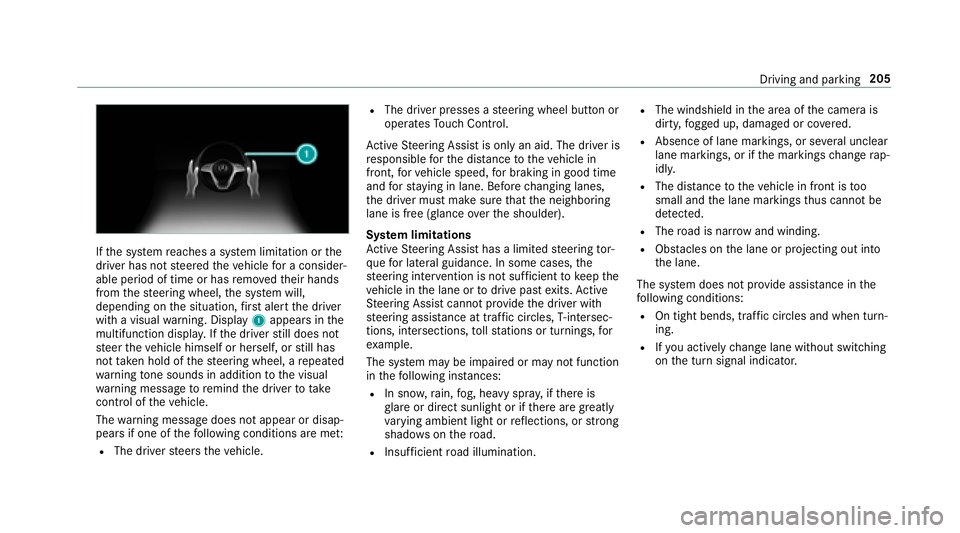
Ifth e sy stem reaches a sy stem limitation or the
driver has not steered theve hicle for a consider‐
able period of time or has remo vedth eir hands
from thesteering wheel, the sy stem will,
depending on the situation, firs t alert the driver
with a visual warning. Display 1appears in the
multifunction displa y.Ifth e driver still does not
st eer theve hicle himself or herself, or still has
not take n hold of thesteering wheel, a repeated
wa rning tone sounds in addition tothe visual
wa rning message toremind the driver totake
control of theve hicle.
The warning message does not appear or disap‐
pears if one of thefo llowing conditions are me t:
RThe driversteers theve hicle.
RThe driver presses a steering wheel button or
operates Touch Control.
Ac tive Steering Assist is only an aid. The driver is
re sponsible forth e dis tance totheve hicle in
front, forve hicle speed, for braking in good time
and forst ay ing in lane. Before changing lanes,
th e driver must make sure that the neighboring
lane is free (glance over the shoulder).
Sy stem limitations
Ac tive Steering Assist has a limited steering tor‐
qu efo r lateral guidance. In some cases, the
st eering inter vention is not suff icienttokeep the
ve hicle in
the lan
e or todrive past exits. Active
St eering Assist cann otprov ide the driver with
st eering assis tance at traf fic circles, T-intersec‐
tions, intersections, tollst ations or turnings, for
ex ample.
The sy stem may be impaired or may not function
in thefo llowing ins tances:
RIn sno w,rain, fog, heavy spr ay, if there is
gl are or direct sunlight or if there are greatly
va rying ambient light or reflections, or strong
shado wsonthero ad.
RInsuf ficient road illumination.
RThe windshield in the area of the camera is
dirty, fogged up, damaged or co vered.
RAbsence of lane markings, or se veral unclear
lane markings, or if the markings change rap‐
idl y.
RThe dis tance totheve hicle in front is too
small and the lane markings thus cannot be
de tected.
RThe road is nar rowand winding.
RObstacles on the lane or projecting out into
th e lane.
The sy stem does not pr ovide assis tance in the
fo llowing conditions:
ROn tight bends, traf fic circles and when turn‐
ing.
RIf yo u act ively change lane without switch ing
on the turn signal indicator.
Driving and parking 205
Page 208 of 562
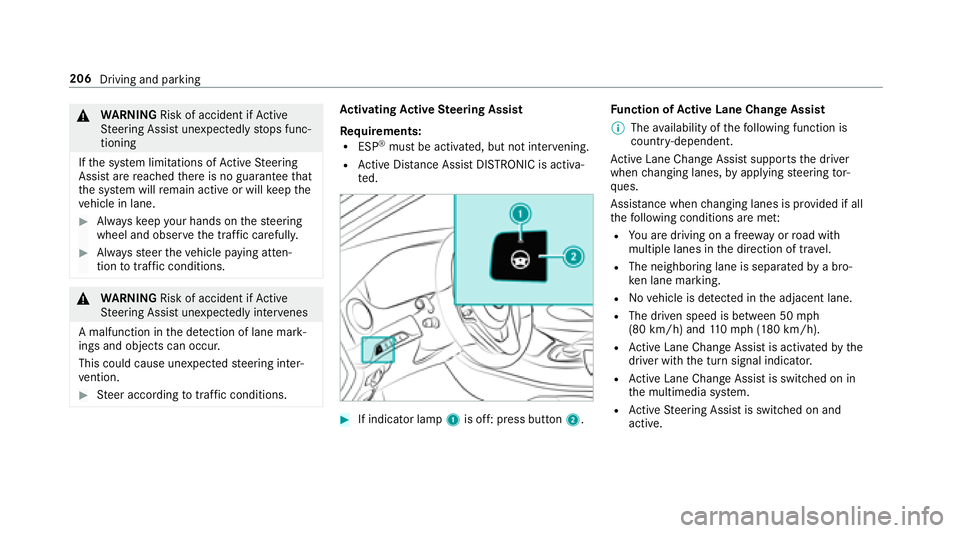
&WARNING Risk of accident if Active
St eering Assist unexpectedly stops func‐
tioning
If th e sy stem limitations of Active Steering
Assist are reached there is no guarantee that
th e sy stem will remain active or will keep the
ve hicle in lane.
#Alw ayske ep your hands onthesteering
wheel and obser vethe tra ffic carefull y.
#Alwaysst eer theve hicle paying atten‐
tion totraf fic conditions.
&
WARNING Risk of accident if Active
St eering Assist unexpectedly inter venes
A malfunction in the de tection of lane mark‐
ings and objects can occur.
This could cause unexpected steering inter‐
ve ntion.
#Steer according totraf fic conditions.
Ac tivating Active Steering Assist
Re quirements:
RESP®must be activated, but not inter vening.
RAc tive Dis tance Assist DISTRONIC is acti va‐
te d.
#If indicator lamp 1is off: press button 2.Fu
nction of Active Lane Change Assi st
% The availability of thefo llowing function is
countr y-dependent.
Ac tive Lane Change Assi stsupports the driver
when changing lanes, byapplying steering tor‐
qu es.
Assis tance when changing lanes is pr ovided if all
th efo llowing conditions are me t:
RYou are driving on a free wayor road with
multiple lanes in the direction of tr avel.
RThe neighboring lane is separated bya bro‐
ke n lane mark ing.
RNovehicle is de tected in the adjacent lane.
RThe driven speed is between 50 mph
(80 km/h) and 110mp h(1 80 km/h).
RAc tive Lane Change Assi stis activated bythe
driver with the turn signal indicator.
RAc tive Lane Change Assi stis switched on in
th e multimedia sy stem.
RAc tive Steering Assist is switched on and
active.
206 Driving and parking
Page 209 of 562
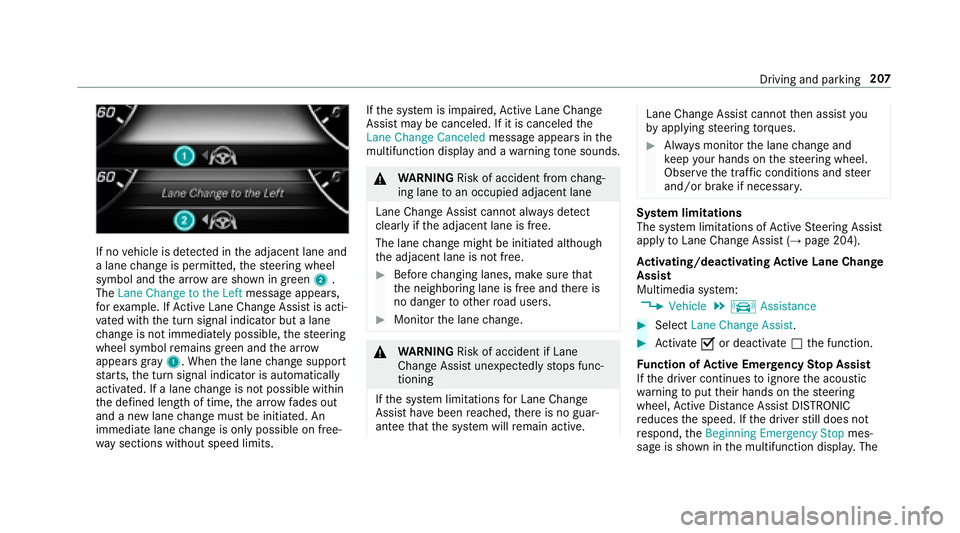
If novehicle is de tected in the adjacent lane and
a lane change is permitte d,thesteering wheel
symbol and the ar row are shown in green 2.
The �/�D�Q�H �&�K�D�Q�J�H �W�R �W�K�H �/�H�I�W message appears,
fo rex ample. If Active Lane Change Assi stis acti‐
va ted with the turn signal indicator but a lane
ch ange is not immediately possible, thesteering
wheel symbol remains green and the ar row
appears gr ay1. When the lane change support
st arts, the turn signal indicator is automatically
activated. If a lane change is not possible within
th e defined length of time, the ar row fa des out
and a new lane change must be initiated. An
immediate lane change is only possible on free‐
wa ysection swithout speed limits .If
th e sy stem is impaired, Active Lane Change
Assi stmay be canceled. If it is canceled the
�/�D�Q�H �&�K�D�Q�J�H �&�D�Q�F�H�O�H�G message appears inthe
multifunction display and a warning tone sounds.
&
WARNING Risk of accident from chang‐
ing lane toan occupied adjacent lane
Lane Change Assistcannot al ways detect
clear lyifth e adjacent lane is free.
The lane change might be initiated although
th e adjacent lane is not free.
#Before changing lanes, make sure that
th e neighboring lane is free and there is
no danger to otherroad users.
#Monitor the lane change.
&
WARNING Risk of accident if Lane
Change Assist unexpectedlystops func‐
tioning
If th e sy stem limitations for Lane Change
Assist ha vebeen reached, there is no guar‐
antee that the sy stem will remain active.
Lane Change Assist cannot then assist you
by applying steering torques .
#Always monitor the lane change and
ke ep your hands on thesteering wheel.
Obser vethe tra ffic conditions and steer
and/or brake if necessar y.
System limitations
The sy stem limitations of Active Steering Assist
apply toLane Change Assist (
→page 204).
Ac tivating/deactivating Active Lane Change
Assi st
Multimedia sy stem:
,�9�H�K�L�F�O�H.k �$�V�V�L�V�W�D�Q�F�H
#Select �/�D�Q�H �&�K�D�Q�J�H �$�V�V�L�V�W .
#Activate Oor deacti vate ª the function.
Fu nction of Active Eme rgency Stop Assist
If th e driver continues toigno rethe acoustic
wa rning toput their hands on thesteering
wheel, Active Dis tance Assist DISTRONIC
re duces the speed. If the driver still does not
re spond, the�%�H�J�L�Q�Q�L�Q�J �(�P�H�U�J�H�Q�F�\ �6�W�R�S mes‐
sage is shown in the multifunction displa y.The
Driving and parking 207
Page 226 of 562
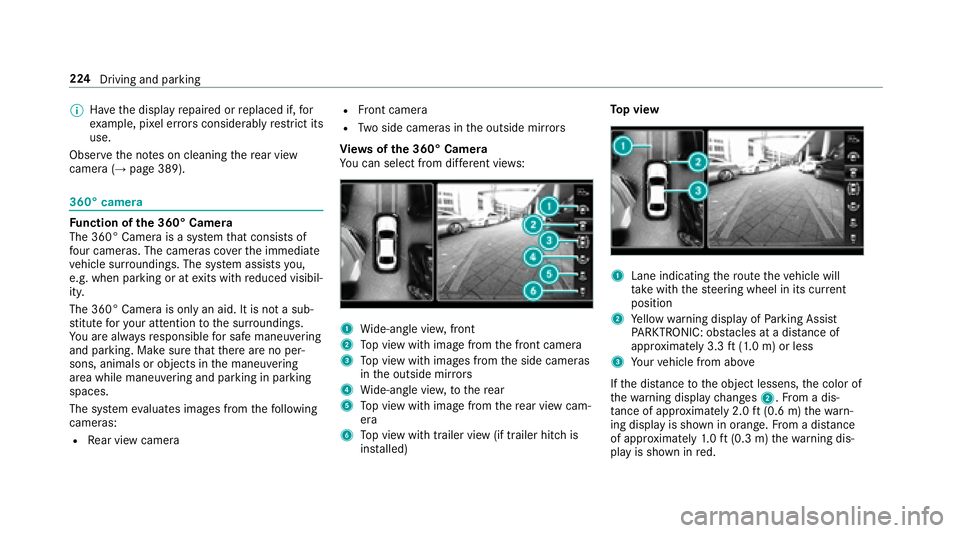
%Have the display repaired or replaced if, for
ex ample, pixel er rors considerably restrict its
use.
Obser vethe no tes on cleaning there ar view
camera (
→page 389).
360° camera
Fu nction of the 360° Camera
The 360° Camera is a sy stem that consists of
fo ur cameras. The cameras co verth e immediate
ve hicle sur roundings. The sy stem assists you,
e.g. when parking or at exits with reduced visibil‐
ity.
The 360° Camera is only an aid. It is not a sub‐
st itute foryo ur attention tothe sur roundings.
Yo u are alw aysre sponsible for safe maneu vering
and pa rking. Make sure that there are no per‐
sons, animals or objects in the maneuvering
area while maneuvering and parking in parking
spaces.
The sy stem evaluates images from thefo llowing
cameras:
RRe ar view camera
RFront camera
RTw o side cameras in the outside mir rors
Vi ew s of the 360° Camera
Yo u can select from dif fere nt vie ws:
1Wide-angle vie w,front
2Top view with image from the front camera
3To p view with images from the side cameras
in the outside mir rors
4Wi de-angle vie w,tothere ar
5To p view with image from there ar view cam‐
era
6To p view with trailer view (if trailer hitch is
ins talled) To
p view
1Lane indicating thero ute theve hicle will
ta ke with thesteering wheel in its cur rent
position
2Ye llow warning display of Parking Assist
PA RKTRONIC: obstacles at adis tance of
appr oximately 3.3 ft(1.0 m) or less
3Yo ur vehicle from abo ve
If th e dis tance tothe object lessens, the color of
th ewa rning display changes 2.From a dis‐
ta nce of appr oximately 2.0 ft(0.6 m) thewa rn‐
ing display is shown in orange. From a dis tance
of appr oximately 1.0 ft (0.3 m) thewa rning dis‐
play is shown in red.
224
Driving and parking